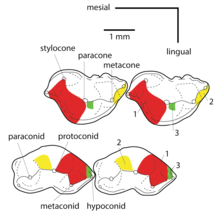| Kuehneotherium | |
|---|---|

| |
| Upper and lower molars of Kuehneotherium | |
| Scientific classification | |
| Domain: | Eukaryota |
| Kingdom: | Animalia |
| Phylum: | Chordata |
| Clade: | Synapsida |
| Clade: | Therapsida |
| Clade: | Cynodontia |
| Clade: | Mammaliaformes |
| Family: | †Kuehneotheriidae |
| Genus: | †Kuehneotherium D.M. Kermack et al., 1968 |
| Type species | |
| †Kuehneotherium praecursoris D.M. Kermack et al., 1968
| |
| Other species | |
| |
Kuehneotherium is an early mammaliaform genus, previously considered a holothere, that lived during the Late Triassic-Early Jurassic Epochs and is characterized by reversed-triangle pattern of molar cusps.[2] Although many fossils have been found, the fossils are limited to teeth, dental fragments, and mandible fragments. The genus includes Kuehneotherium praecursoris and all related species. It was first named and described by Doris M. Kermack, K. A. Kermack, and Frances Mussett in November 1967. The family Kuehneotheriidae and the genus Kuehneotherium were created to house the single species Kuehneotherium praecursoris. Modeling based upon a comparison of the Kuehneotherium jaw with other mammaliaforms indicates it was about the size of a modern-day shrew between 4 and 5.5 g at adulthood.
Kuehneotherium is thought to be an insectivore that could consume only soft-bodied insects such as moths. Its teeth were shaped for vertical shearing and could not crush harder prey. It lived alongside another early mammaliaform, Morganucodon, which had teeth that could crush harder insects such as beetles. This distinction in diet shows that early mammaliaforms adapted to have separate feeding niches so they would not compete for food.[3][4]
- ^ Cite error: The named reference
Debuysscherewas invoked but never defined (see the help page). - ^ Kermack, Doris M.; Kermack, K.A.; Mussett, Frances (1968). "The Welsh pantothere Kuehneotherium praecursoris". Journal of the Linnean Society of London, Zoology. 47 (312): 407–423. doi:10.1111/j.1096-3642.1968.tb00519.x.
- ^ Gill, Pam, M.D. Morganucodon – lower jaw of an early mammal, Animal Bytes 13 June 2013. Web. retrieved http://animalbytescambridge.wordpress.com/2013/06/05/morganucodon-lower-jaw-of-an-early-mammal/#comments
- ^ Gill, Pamela G.; Purnell, Mark A.; Crumpton, Nick; Brown, Kate Robson; Gostling, Neil J.; Stampanoni, M.; Rayfield, Emily J. (2014). "Dietary specializations and diversity in feeding ecology of the earliest stem mammals". Nature. 512 (7514): 303–305. Bibcode:2014Natur.512..303G. doi:10.1038/nature13622. hdl:2381/29192. PMID 25143112. S2CID 4469841.